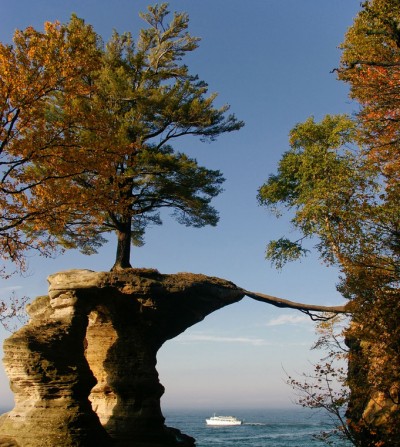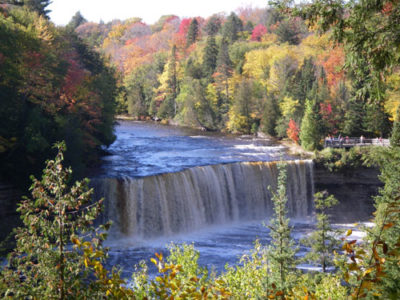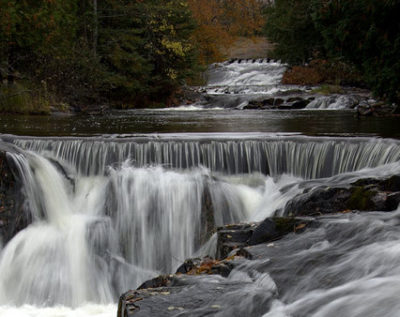Fall Travel: Michigan’s Upper Peninsula
The Sep/Oct issue of The Saturday Evening Post features Editor-in-Chief Stephen C. George’s family memories of scenic New Hampshire in “Living Colors.” New England’s autumn is world renowned, but other places in the U.S. have equally impressive vibrant fall colors, picturesque landscapes, and enchanting forests. Here, we explore Michigan’s Upper Peninsula in the first of a series profiling autumn destinations off the beaten path. Do you have family memories of fall foliage travel? Let us know at [email protected].

With two national forests, America’s first National Lakeshore, and dozens of state parks and woodlands, Michigan’s Upper Peninsula offers as many beautiful fall locales as anywhere in the U.S. Furthermore, it is one of the most isolated places in the mainland. The UP makes up one quarter of Michigan’s land area but is home to only three percent of the state’s population, making it secluded enough that visitors can enjoy natural serenity without getting overrun by “leaf peepers.” Here are some of the most notable places in the UP.
Pictured Rocks National Lakeshore

This destination in north central UP on Lake Superior is worth visiting at any time. There are hundreds of miles of trails, sandstone cliffs, waterfalls, a seemingly endless beach, and sparkling turquoise blue water. Unlike most Great Lake beaches that are simply sandy, Pictured Rocks’ shoreline is strewn with literally billions of small rocks, each a different color, and a reminder that Superior sits on much more rocky terrain than its cousins. Spring brings a myriad of wildflowers, summers are a pleasant 70 degrees, and winter affords snowmobiling and cross country skiing opportunities.

However, Pictured Rocks becomes positively enchanting in fall. Trees such as beech, aspen, maple, and birch put on a show each autumn, their vibrant colors complemented by a palette of evergreen, sandstone, and shimmering blue. An interesting species is the Tamarack, a deciduous conifer tree. Although this may sound like an oxymoron, it is one of only a few trees in the world that sheds needles in fall, changing from a dark evergreen to a golden yellow in the process. Due to the moderating influence of Superior, Pictured Rocks is one of the last places in the UP to experience leaf change even though it is at the northern edge, making it available later in the year. Perhaps best of all, cooler temperatures mean that fall is a time when visitors can enjoy the park without being pestered by what locals call the “UP State Bird”–the mosquito.
Waterfalls

One special thing about the UP is its unique geology. It sits at the southern edge of the Canadian Shield, a feature named because it extends from the Great Lakes all the way around the Hudson Bay into the arctic, giving it a shield-like appearance. In the last ice age, receding glaciers stripped the Shield of most of its topsoil, exposing massive quantities of bedrock. This means water doesn’t easily carve out riverbeds in the UP, but instead travels over unyielding rock. The end result: waterfalls. The UP has over 300 of them, including Tahquamenon Falls , the second largest east of the Mississippi.

It is hard to think of a better example of nature’s beauty than a waterfall surrounded by fall foliage, and this is a sight that welcomes visitors regardless of location on the peninsula. Majestic Tahquamenon is in the east. In the west, Ottawa National Forest offers Agate Falls (see photo at top) and Bond Falls. Chapel, Sable, Munising, and Miners Falls are among over 20 waterfalls in Alger County, which is also the home of the Pictured Rocks. Eagle, Silver, and Canyon Falls await in the northern Keweenaw Peninsula, and Pemene, Rapid River, and Haymeadow Falls exist to the south.
Keweenaw Peninsula

Keweenaw is the Upper Peninsula’s, well, upper peninsula, and its remoteness makes it consistently listed among the top places in America for leaf color road trips. Some say that it is the best place in the U.S. mainland to see another type of fall color—the aurora borealis—for a number of reasons. Keweenaw is, of course, northern. Its small population makes light pollution low. Fall brings clear night skies and one can see for miles across the lake, and it is the season when the aurora begins to pick up.

Keweenaw’s history also makes it worth a visit. It was once home to the largest copper deposit in the world, which American Indians started mining before the Egyptians built the pyramids. Occasionally, visitors stumble across the ancient hammers and tools they used. Copper really boomed in the 1800s, and historical mining ruins are everywhere. One last thing worth seeing is Brockway Mountain Drive. This scenic road travels along the Keweenaw Fault, a remnant of a billion-year-old continental rift system, and offers endless panoramic views.
Special thanks to Brody Block at Pictured Rocks, Charlie Hopper at pasty.com and the good people at michigan.org.